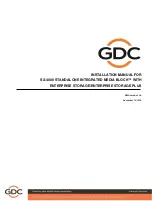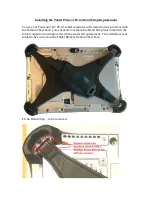
Appendix C. CS700H Operation Details
C-11
YD0!
Ten seconds later, after a total of 40
seconds have passed, the data logger
starts the process of data from sensor
Y by issuing the first
D
command.
Y+1+2+3+4+5+6<CR><LF>
The sensor immediately responds
with the sensor address and the 6
values.
C.6.28 Start Measurement Commands with Cyclic Redundancy Check
(aMC! and aCC!)
Error checking is done by using measurement commands with cyclic
redundancy checks (
aMC!
or
aCC!
). This is most commonly implemented
when long cable lengths or electronic noise may impact measurement
transmission to the data logger. When these commands are used, the data
returned in response to
D
or
R
commands must have a cyclic redundancy
check (CRC) code appended to it. The CRC code is a 16-bit value encoded
within 3 characters appended before the <CR><LF>. This code is not returned
in the data table but checked by the data logger as it comes. The code returned
is based on the SDI-12 protocol. See the SDI-12 communication specification
to learn more about how the CRC
code is developed.
C.6.2.9 Stopping a Measurement Command
A measurement command (
M!
) is stopped if it detects a break signal. A break
signal is sent by the data logger before most commands.
A concurrent measurement command (
C!
) is aborted when another valid
command is sent to the sensor before the measurement time has elapsed.
C.6.2.10 Send Data Command (aD0! … aD9!)
The Send Data command requests data from the sensor. It is issued
automatically with every type of measurement command (
aM!
,
aMC!
,
aC!
,
aCC!
). When the measurement command is
aM!
or
aMC!
, the data logger
issues the
aD0!
command once a service request has been received from the
sensor. When the data logger is issuing concurrent commands (
aC!
or
aCC!
),
the Send Data command is issued after the required time has elapsed (no
service request will be sent by the sensor). In transparent mode (Appendix
(p. C-12)
), the user asserts this command to
obtain data.
Depending on the type of data returned and the number of values a sensor
returns, the data logger may need to issue
aD0!
up to
aD9!
to retrieve all data.
A sensor may return up to 35 characters of data in response to a
D
command
that follows an
M!
or
MC!
command. A sensor may return up to 75 characters
of data in response to a
D
command that follows a
C!
or
CC!
command.
Command:
aD0!
(
aD1! … aD9!
)
Response:
a<values><CR><LF>
or
a<values><CRC><CR><LF>




































